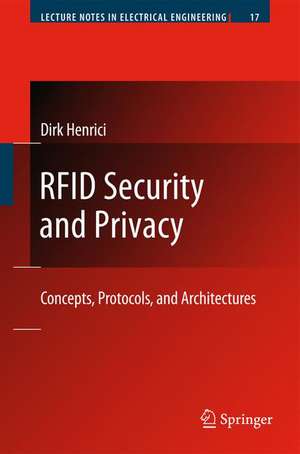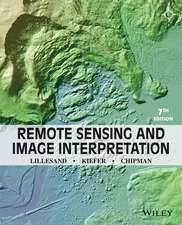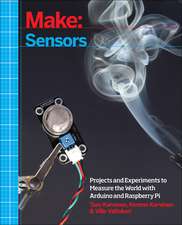RFID Security and Privacy: Concepts, Protocols, and Architectures: Lecture Notes in Electrical Engineering, cartea 17
Autor Dirk Henricien Limba Engleză Hardback – 29 mai 2008
| Toate formatele și edițiile | Preț | Express |
|---|---|---|
| Paperback (1) | 943.88 lei 6-8 săpt. | |
| Springer Berlin, Heidelberg – 28 oct 2010 | 943.88 lei 6-8 săpt. | |
| Hardback (1) | 950.03 lei 6-8 săpt. | |
| Springer Berlin, Heidelberg – 29 mai 2008 | 950.03 lei 6-8 săpt. |
Din seria Lecture Notes in Electrical Engineering
- 18%
 Preț: 1859.04 lei
Preț: 1859.04 lei - 18%
 Preț: 895.27 lei
Preț: 895.27 lei - 17%
 Preț: 397.66 lei
Preț: 397.66 lei - 18%
 Preț: 1562.17 lei
Preț: 1562.17 lei - 20%
 Preț: 1473.39 lei
Preț: 1473.39 lei - 18%
 Preț: 5169.60 lei
Preț: 5169.60 lei - 20%
 Preț: 1741.49 lei
Preț: 1741.49 lei - 20%
 Preț: 1918.04 lei
Preț: 1918.04 lei - 18%
 Preț: 1573.20 lei
Preț: 1573.20 lei - 18%
 Preț: 1851.77 lei
Preț: 1851.77 lei - 18%
 Preț: 1578.72 lei
Preț: 1578.72 lei - 18%
 Preț: 1903.08 lei
Preț: 1903.08 lei - 18%
 Preț: 2113.02 lei
Preț: 2113.02 lei - 18%
 Preț: 892.42 lei
Preț: 892.42 lei - 18%
 Preț: 1404.30 lei
Preț: 1404.30 lei - 18%
 Preț: 1133.61 lei
Preț: 1133.61 lei - 18%
 Preț: 1847.84 lei
Preț: 1847.84 lei - 18%
 Preț: 1384.56 lei
Preț: 1384.56 lei - 20%
 Preț: 1300.14 lei
Preț: 1300.14 lei - 20%
 Preț: 1174.76 lei
Preț: 1174.76 lei - 20%
 Preț: 1310.03 lei
Preț: 1310.03 lei - 18%
 Preț: 2546.29 lei
Preț: 2546.29 lei - 20%
 Preț: 1310.03 lei
Preț: 1310.03 lei - 18%
 Preț: 1676.58 lei
Preț: 1676.58 lei - 20%
 Preț: 1182.20 lei
Preț: 1182.20 lei - 18%
 Preț: 1392.46 lei
Preț: 1392.46 lei - 18%
 Preț: 1119.38 lei
Preț: 1119.38 lei - 18%
 Preț: 1678.16 lei
Preț: 1678.16 lei - 18%
 Preț: 1596.85 lei
Preț: 1596.85 lei - 18%
 Preț: 1398.00 lei
Preț: 1398.00 lei - 20%
 Preț: 1445.35 lei
Preț: 1445.35 lei - 18%
 Preț: 1244.89 lei
Preț: 1244.89 lei - 20%
 Preț: 1173.10 lei
Preț: 1173.10 lei - 18%
 Preț: 810.81 lei
Preț: 810.81 lei - 20%
 Preț: 1173.93 lei
Preț: 1173.93 lei - 20%
 Preț: 1482.47 lei
Preț: 1482.47 lei - 20%
 Preț: 1915.57 lei
Preț: 1915.57 lei - 18%
 Preț: 1387.73 lei
Preț: 1387.73 lei - 18%
 Preț: 1425.62 lei
Preț: 1425.62 lei - 20%
 Preț: 1297.67 lei
Preț: 1297.67 lei - 18%
 Preț: 1407.46 lei
Preț: 1407.46 lei - 18%
 Preț: 1667.91 lei
Preț: 1667.91 lei - 18%
 Preț: 1400.35 lei
Preț: 1400.35 lei - 18%
 Preț: 1117.03 lei
Preț: 1117.03 lei - 18%
 Preț: 1573.20 lei
Preț: 1573.20 lei - 18%
 Preț: 1405.90 lei
Preț: 1405.90 lei - 18%
 Preț: 726.37 lei
Preț: 726.37 lei - 18%
 Preț: 1405.90 lei
Preț: 1405.90 lei - 18%
 Preț: 1238.56 lei
Preț: 1238.56 lei - 18%
 Preț: 725.61 lei
Preț: 725.61 lei
Preț: 950.03 lei
Preț vechi: 1158.57 lei
-18% Nou
Puncte Express: 1425
Preț estimativ în valută:
181.81€ • 197.42$ • 152.72£
181.81€ • 197.42$ • 152.72£
Carte tipărită la comandă
Livrare economică 23 aprilie-07 mai
Preluare comenzi: 021 569.72.76
Specificații
ISBN-13: 9783540790754
ISBN-10: 3540790756
Pagini: 284
Ilustrații: XI, 269 p.
Dimensiuni: 155 x 235 x 25 mm
Greutate: 0.58 kg
Ediția:2008
Editura: Springer Berlin, Heidelberg
Colecția Springer
Seria Lecture Notes in Electrical Engineering
Locul publicării:Berlin, Heidelberg, Germany
ISBN-10: 3540790756
Pagini: 284
Ilustrații: XI, 269 p.
Dimensiuni: 155 x 235 x 25 mm
Greutate: 0.58 kg
Ediția:2008
Editura: Springer Berlin, Heidelberg
Colecția Springer
Seria Lecture Notes in Electrical Engineering
Locul publicării:Berlin, Heidelberg, Germany
Public țintă
ResearchCuprins
Motivation and Vision.- Fundamentals.- Analysis and Modeling.- Securing RFID Systems.- Pseudonymization Infrastructures.- Extending the RFID System Model.- Current Research.
Textul de pe ultima copertă
RFID technology is already used widely and is increasingly becoming a part of daily life. However, issues regarding security and privacy with respect to RFID technology have not been resolved satisfactorily. The challenges which must be overcome to resolve RFID security and privacy issues are immense; primarily because of the many constraints attached to the provision of security and privacy in RFID systems. These challenges are chiefly technical and economic in nature but also include ethical and social issues. Along with meeting the security and privacy needs of RFID technology, solutions must be inexpensive, practical, reliable, scalable, flexible, inter-organizational, and long lasting.
The book analyses in detail the problems currently being faced by researchers working in the field of RFID technology and discusses the goals and attacker models. This is followed by an introduction to state-of-the-art of RFID security and privacy systems technology. The concepts which underlie the proposed protocols are highlighted, explained, and illustrated using examples. For building open, inter-organizational RFID systems, the classic RFID model is extended and considerations in new directions are explored. RFID systems are then integrated into other parts of the pervasive computing vision. Among the current research results presented in this book, a new comprehensive framework, including required protocols for operation, is introduced. It can be used economically on a global scope, supports inter-organizational cooperation and data sharing, and adheres to all the architectural guidelines derived in this work.
The book analyses in detail the problems currently being faced by researchers working in the field of RFID technology and discusses the goals and attacker models. This is followed by an introduction to state-of-the-art of RFID security and privacy systems technology. The concepts which underlie the proposed protocols are highlighted, explained, and illustrated using examples. For building open, inter-organizational RFID systems, the classic RFID model is extended and considerations in new directions are explored. RFID systems are then integrated into other parts of the pervasive computing vision. Among the current research results presented in this book, a new comprehensive framework, including required protocols for operation, is introduced. It can be used economically on a global scope, supports inter-organizational cooperation and data sharing, and adheres to all the architectural guidelines derived in this work.
Caracteristici
Follows the items from the basics to the frontiers of research Modular Structure: The Reader can pick out the interesting items of the content Includes introduction into all necessary items - no deep background knowledge required











